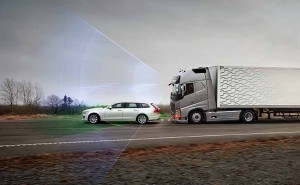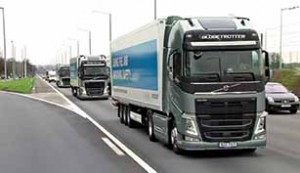Intelligent and innovative safety technologies developed by Volvo Trucks promise zero accidents.
Story by: Anirudh Raheja
Safety is endemic to the Swedish society. It lays much emphasis on accident prevention. If this will help to explain why safety is synonymous with Volvo, which has a long history of establishing safety milestones, at its Experience Centre in Gothenburg, Sweden, recently provided an insight into the safety technologies it has developed. With high commitment to safety, the Swedish truck giant is working on a plethora of technologies that could lead to connected vehicles, and eventually to truly autonomous machines. Present in 68 countries, including India, Volvo Trucks is pro-actively expanding the envelope of automotive safety. With an eye on rising vehicular population, and the resulting challenges, the company is focusing on smart safety technologies like emergency braking and collision warning.
The root of both these technologies lies in accidents where the following vehicle rear-ends the vehicle ahead. The results of which are often disastrous. Underlining the phenomenon of better infrastructure leading to more vehicles and higher traffic speeds, Helene Mellquist, Senior Vice President, Volvo Trucks International, expressed that rear-end collisions account for one-fifth of the overall accidents that involve trucks. “Since November 2015, it is mandatory to equip every two and three-axle trucks with an automatic emergency braking system across the European Union,” she said. According to the EU legislation, the braking system should be effective in slowing down a truck by 10 kmph. The target for next year is 20 kmph. Of the opinion that the amount of jerk that will emanate from such an excercise will cause the driver pain. To avoid this, Volvo Trucks, according to Carl Johan Almqvist, Traffic and Products Safety Director, has developed a system that alerts the driver well in advance. If the driver does not pay heed to the warning, the emergency brakes are applied. Mentioned Almqvist, “If you are driving at 80 kmph when the emergency braking system is deployed, there is a need to cut down the speed by more than 20 kmph to avoid a nasty collision because the vehicle ahead has come to a standstill.”
Offering a first-hand feel of the technology on a Volvo FH16 750 carrying a load of over 40-tonnes, the engineers of the company explained how the system works. Noticing another vehicle in front, the truck shed speed from 80 kmph to a standstill in less than 40 m. The braking speed recorded was up to seven-meter per second square. The system, with standard ABS deployed on both the tractor and the trailer, is laced with a camera and radar technology to monitor the vehicular movement ahead of the truck. It is engineered to brave adverse weather conditions. Sensing the risk of a collision, the system gives out a sharp audio warning, closely followed by an escalating lighting combination. If the driver fails to respond, emergency braking is activated. At other times, when the system notices a lack of steering movement, it engages the parking brake in five seconds to avoid a roll over. To warn the following traffic, brakes lights begin to flash.
Self-driving refuse truck
The self-driving refuse truck Volvo engineers have developed in association with Renova aims for safer, and efficient refuse handling. It provides an insight into how the refuse trucks of tomorrow will be like; how safe they will be. Meant to create a better working environment for drivers, the truck is driven manually the first time it visits a locality. The on-board system constantly monitors and maps the route with the help of sensors and GPS technology. The next time the truck visits the locality, it knows exactly which route to follow, and at which bins to stop. At the first stop with the automated system activated, the driver climbs out of the cab, goes to the rear of the truck, brings out the wheelie-bin and empties it exactly the way it is done with a conventional refuse truck. When the operation is completed, the truck automatically reverses to the next bin upon receiving the driver’s command. The driver walks the very same route that the truck takes. He thus has a full view of what’s happening in the direction of travel always.
By reversing the truck, the driver can constantly remain close to the compactor unit instead of having to repeatedly walk between the rear and the cab every time the truck is on the move. And since the driver doesn’t have to climb in and out of the cab at every start and stop, there’s less risk of work related injuries such as strain on the knees and other joints. Carrying the same genetic pattern of autonomous Volvo trucks operating in Kristineberg mine in northern Sweden, the autonomous refuse truck, according to Almqvist, comes to an immediate halt if the sensors monitoring the surrounding area notice another object in close vicinity. The commercial application of such a refuse truck is still some time away. There’s more research to be done, and especially in the wake of the regulation that does not allow trucks to be reversed for reasons of safety. Issues like these, and others need to be addressed. A detailed story on the autonomous refuse truck is featured ahead in the issue.
Platooning
A convoy of three Volvo FH trucks, as part of an exercise to forward the cause of vehicle automation, under the supervision of the Dutch government, travelled from the Volvo headquarters at Gothenburg to Rotterdam in March 2017. As part of the European Union truck platooning challenge, the three Volvo trucks were driven through five countries while communicating wirelessly with each other through cameras and radars. The communication between the trucks was carried out through G5, a special frequency dealing with encrypted data traffic. The frequency enabled either truck to match the speed of the other trucks, which is essential to a platoon. With a one-second gap between the two trucks, the rate of acceleration and deceleration matched. A glimpse of how the system works was had with the camera fitted on the lead truck sending the footage to the two other trucks in the platoon. While the other drivers continued to steer the vehicle, acceleration and braking was automated. Traveling at 80 kmph, the trucks in the platoon maintained a 22 m gap between each other. The seemingly small gap reduced wind drag. Developing autonomous steering as an effort to reach the goal of a truly self-driving truck, Volvo is aware of the associated risks; the need for the drivers to be ready, and to accept it commercially.
Visibility and driver awareness
Volvo Trucks is working closely with the Swedish Government to impart training to drivers through the Swedish National Road and Transport Research Institute (VTI), Lindholmen. VTI, in 2011, inaugurated its Sim IV simulator, which produces a large stroke liner motion in both lateral and longitudinal directions. A system consists of three LCD screens for rear view mirrors and nine projector modules for 180 degree forward field view. It is designed such that it studies the driver reactions and imparts training on maneouvring the truck in different situations. The number of accidents involving trucks has fallen as per the Volvo Trucks Safety Report for 2017. The report has mentioned that there are still a considerable number of drivers who do not wear a seat belt. Highlighting the need to focus on pedestrian safety, and that of the cyclists and motorcycles, the report has emphasized on active safety measures like increased seat belt usage, driver awareness as well as direct and indirect visibility from the cab, driver coaching services that provide direct feedback to the driver, and Advanced Emergency Braking (AEB) system.
The current AEB system as per the legislature, is designed to mitigate or avoid rear-end accidents. It will have to, in the future, include scenarios involving pedestrians and cyclists (VRUs). This would call for detection systems that identify VRUs in close proximity to a truck. Also, Cooperative Intelligent Traffic Systems (C-ITS) that enable communication between vehicles and infrastructure. Opined Peter Wells, Head, Volvo Trucks Accident Research, “Often there are these minor factors that foster a safe environment. They also lead to product improvement.” Volvo engineers have set up cameras that complement the rear view mirrors. The combination of cameras and mirrors is aimed at eliminating the limitations posed by a human eye. “There are blind spots around the truck for a driver. Different traffic situations call for them to be dealt accordingly. It is a joint responsibility of the society to see and be seen to elevate road safety,” averred Almqvist. He concluded, that it is important to educate the young and the adults.






























